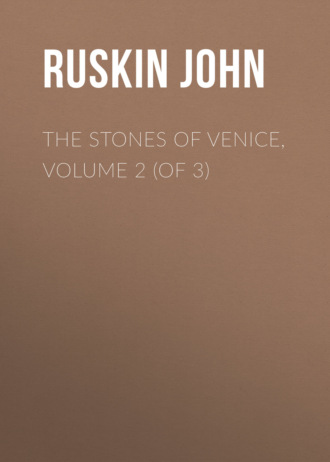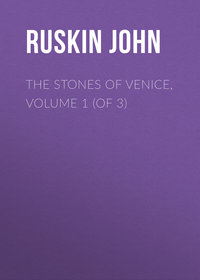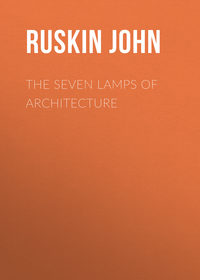 полная версия
полная версияThe Stones of Venice, Volume 2 (of 3)
63
The reader will understand this in a moment by glancing at Plate XX., the last in this volume, where the series 1 to 12 represents the change in one kind of leaf, from the Byzantine to the perfect Gothic.
64
The best art either represents the facts of its own day, or, if facts of the past, expresses them with accessories of the time in which the work was done. All good art, representing past events, is therefore full of the most frank anachronism, and always ought to be. No painter has any business to be an antiquarian. We do not want his impressions or suppositions respecting things that are past. We want his clear assertions respecting things present.
65
See the account of the meeting at Talla Linns, in 1682, given in the fourth chapter of the “Heart of Midlothian.” At length they arrived at the conclusion that “they who owned (or allowed) such names as Monday, Tuesday, January, February, and so forth, served themselves heirs to the same if not greater punishment than had been denounced against the idolaters of old.”
66
See the beautiful description of Florence in Elizabeth Browning’s “Casa Guidi Windows,” which is not only a noble poem, but the only book I have seen which, favoring the Liberal cause in Italy, gives a just account of the incapacities of the modern Italian.
67
Salisbury spire is only a tower with a polygonal gabled roof of stone, and so also the celebrated spires of Caen and Coutances.
68
Or by the shaded portions of Vol. I.
69
The reader is not to suppose that Greek architecture had always, or often, flat ceilings, because I call its lintel the roof proper. He must remember I always use these terms of the first simple arrangements of materials that bridge a space; bringing in the real roof afterwards, if I can. In the case of Greek temples it would be vain to refer their structure to the real roof, for many were hypæthral, and without a roof at all. I am unfortunately more ignorant of Egyptian roofing than even of Arabian, so that I cannot bring this school into the diagram; but the gable appears to have been magnificently used for a bearing roof. Vide Mr. Fergusson’s section of the Pyramid of Geezeh, “Principles of Beauty in Art,” Plate I., and his expressions of admiration of Egyptian roof masonry, page 201.
70
See ‘Athenæum,’ March 5th, 1853.
71
Late, and chiefly confined to Northern countries, so that the two schools may be opposed either as Early and Late Gothic, or (in the fourteenth century) as Southern and Northern Gothic.
72
In many of the best French Gothic churches, the groups of figures have been all broken away at the Revolution, without much harm to the picturesqueness, though with grievous loss to the historical value of the architecture: whereas, if from the niche at Verona we were to remove its floral ornaments, and the statue beneath it, nothing would remain but a rude square trefoiled shell, utterly valueless, or even ugly.
73
38 ft. 2 in., without its cornice, which is 10 inches deep, and sustains pinnacles of stone 7 feet high. I was enabled to get the measures by a scaffolding erected in 1851 to repair the front.
74
I believe the necessary upper joint is vertical, through the uppermost lobe of the quatrefoil, as in the figure; but I have lost my memorandum of this joint.
75
“Dice, che non lauda per alcun modo di metter questo Serenissimo Dominio in tanto pericolo d’ habitar un palazzo fabricato in aria.”—Pareri di XV. Architetti, con illustrazioni dell’ Abbate Giuseppe Cadorin (Venice, 1838), p. 104.
76
“Il muro della sala è più grosso delle colonne sott’ esso piedi uno e onze tre, et posto in modo che onze sei sta come in aere sopra la piazza, et onze nove dentro.”—Pareri di XV. Architetti, p. 47.
77
Compare “Seven Lamps,” chap. iii. § 7.
78
Pareri, above quoted, p. 21.
79
It is a curious proof how completely, even so early as the beginning of the sixteenth century, the Venetians had lost the habit of reading the religious art of their ancient churches, that Sanuto, describing this injury, says, that “four of the Kings in marble fell from their pinnacles above the front, at St. Mark’s church;” and presently afterwards corrects his mistake, and apologises for it thus: “These were four saints, St. Constantine, St. Demetrius, St. George, and St. Theodore, all Greek saints. They look like Kings.” Observe the perfect, because unintentional, praise given to the old sculptor.
80
I am not speaking here of iron balconies. See below, § XXII.
81
A Some details respecting the mechanical structure of the Venetian balcony are given in the final Appendix.
82
I found it convenient in my own memoranda to express them simply as fourths, seconds, &c. But “order” is an excellent word for any known group of forms, whether of windows, capitals, bases, mouldings, or any other architectural feature, provided always that it be not understood in any wise to imply preëminence or isolation in these groups. Thus I may rationally speak of the six orders of Venetian windows, provided I am ready to allow a French architect to speak of the six or seven, or eight, or seventy or eighty, orders of Norman windows, if so many are distinguishable; and so also we may rationally speak, for the sake of intelligibility, of the five orders of Greek pillars, provided only we understand that there may be five millions of orders as good or better, of pillars not Greek.
83
Or in their own curves; as, on a small scale, in the balustrade fig. 6, Plate XIII., above.
84
For all details of this kind, the reader is referred to the final Appendix in Vol. III.
85
Two threads of white marble, each about an inch wide, inlaid in the dark grey pavement, indicate the road to the Rialto from the farthest extremity of the north quarter of Venice. The peasant or traveller, lost in the intricacy of the pathway in this portion of the city, cannot fail, after a few experimental traverses, to cross these white lines, which thenceforward he has nothing to do but to follow, though their capricious sinuosities will try his patience not a little.
86
An account of the conspiracy of Bajamonte may be found in almost any Venetian history; the reader may consult Mutinelli, Annali Urbani, lib. iii.
87
See account of series of capitals in final Appendix.
88
If the traveller desire to find them (and they are worth seeking), let him row from the Fondamenta S. Biagio down the Rio della Tana, and look, on his right, for a low house with windows in it like those in the woodcut No. XXXI. above, p. 256. Let him go in at the door of the portico in the middle of this house, and he will find himself in a small alley, with the windows in question on each side of him.
89
The bitterness of feeling with which the Venetians must have remembered this, was probably the cause of their magnificent heroism in the final siege of the city under Dandolo, and, partly, of the excesses which disgraced their victory. The conduct of the allied army of the Crusaders on this occasion cannot, however, be brought in evidence of general barbarism in the thirteenth century: first, because the masses of the crusading armies were in great part composed of the refuse of the nations of Europe; and secondly, because such a mode of argument might lead us to inconvenient conclusions respecting ourselves, so long as the horses of the Austrian cavalry are stabled in the cloister of the convent which contains the Last Supper of Leonardo da Vinci. See Appendix 3, Vol. III.: “Austrian Government in Italy.”
90
It is generally better to read ten lines of any poet in the original language, however painfully, than ten cantos of a translation. But an exception may be made in favor of Cary’s Dante. If no poet ever was liable to lose more in translation, none was ever so carefully translated; and I hardly know whether most to admire the rigid fidelity, or the sweet and solemn harmony, of Cary’s verse. There is hardly a fault in the fragment quoted above, except the word “lectured,” for Dante’s beautiful “favoleggiava;” and even in this case, joining the first words of the following line, the translation is strictly literal. It is true that the conciseness and the rivulet-like melody of Dante must continually be lost; but if I could only read English, and had to choose, for a library narrowed by poverty, between Cary’s Dante and our own original Milton, I should choose Cary without an instant’s pause.
91
See final Appendix, Vol. III., under head “Capitals.”
92
This Plate is not from a drawing of mine. It has been engraved by Mr. Armytage, with great skill, from two daguerreotypes.
93
Vide final Appendix, under head “Archivolt.”
94
“On Thursday, the 20th, the front walls of two of the new houses now building in Victoria Street, Westminster, fell to the ground.... The roof was on, and a massive compo cornice was put up at top, as well as dressings to the upper windows. The roof is formed by girders and 4½-brick arches in cement, covered with asphalt to form a flat. The failure is attributed to the quantity of rain which has fallen. Others suppose that some of the girders were defective, and gave way, carrying the walls with them.”—Builder, for January 29th, 1853. The rest of this volume might be filled with such notices, if we sought for them.
95
“Ysame,” collected together.
96
Vol. III. Chap. I. I have had considerable difficulty in the arrangement of these volumes, so as to get the points bearing upon each other grouped in consecutive and intelligible order.
97
The reader will find it convenient to note the following editions of the printed books which have been principally consulted in the following inquiry. The numbers of the manuscripts referred to in the Marcian Library are given with the quotations.
Sansovino. Venetia Descritta. 4to, Venice, 1663.
Sansovino. Lettera intorno al Palazzo Ducale. 8vo, Venice, 1829.
Temanza. Antica Pianta di Venezia, with text. Venice, 1780.
Cadorin. Pareri di XV. Architetti. 8vo, Venice, 1838.
Filiasi. Memorie storiche. 8vo, Padua, 1811.
Bettio. Lettera discorsiva del Palazzo Ducale. 8vo, Venice, 1837.
Selvatico. Architettura di Venezia. 8vo, Venice, 1847.
98
The year commonly given is 810, as in the Savina Chronicle (Cod. Marcianus), p. 13. “Del 810 fece principiar el pallazzo Ducal nel luogo ditto Bruolo in confin di S. Moisè, et fece riedificar la isola di Eraclia.” The Sagornin Chronicle gives 804; and Filiasi, vol. vi. chap. 1, corrects this date to 813.
99
“Ampliò la città, fornilla di casamenti, e per il culto d’ Iddio e l’ amministrazione della giustizia eresse la cappella di S. Marco, e il palazzo di sua residenza.”—Pareri, p. 120. Observe, that piety towards God, and justice towards man, have been at least the nominal purposes of every act and institution of ancient Venice. Compare also Temanza, p. 24. “Quello che abbiamo di certo si è che il suddetto Agnello lo incominciò da fondamenti, e cost pure la cappella ducale di S. Marco.”
100
What I call the Sea, was called “the Grand Canal” by the Venetians, as well as the great water street of the city; but I prefer calling it “the Sea,” in order to distinguish between that street and the broad water in front of the Ducal Palace, which, interrupted only by the island of San Giorgio, stretches for many miles to the south, and for more than two to the boundary of the Lido. It was the deeper channel, just in front of the Ducal Palace, continuing the line of the great water street itself which the Venetians spoke of as “the Grand Canal.” The words of Sansovino are: “Fu cominciato dove si vede, vicino al ponte della paglia, et rispondente sul canal grande.” Filiasi says simply: “The palace was built where it now is.” “Il palazio fu fatto dove ora pure esiste.”—Vol. iii. chap. 27. The Savina Chronicle, already quoted, says: “In the place called the Bruolo (or Broglio), that is to say, on the Piazzetta.”
101
“Omni decoritate illius perlustrata.”—Sagornino, quoted by Cadorin and Temanza.
102
There is an interesting account of this revolt in Monaci, p. 68. Some historians speak of the palace as having been destroyed entirely; but, that it did not even need important restorations, appears from Sagornino’s expression, quoted by Cadorin and Temanza. Speaking of the Doge Participazio, he says: “Qui Palatii hucusque manentis fuerit fabricator.” The reparations of the palace are usually attributed to the successor of Candiano, Pietro Orseolo I.; but the legend, under the picture of that Doge in the Council Chamber, speaks only of his rebuilding St. Mark’s, and “performing many miracles.” His whole mind seems to have been occupied with ecclesiastical affairs; and his piety was finally manifested in a way somewhat startling to the state, by his absconding with a French priest to St. Michael’s, in Gascony, and there becoming a monk. What repairs, therefore, were necessary to the Ducal Palace, were left to be undertaken by his son, Orseolo II., above named.
103
“Quam non modo marmoreo, verum aureo compsit ornamento.”—Temanza, p. 25.
104
“L’anno 1106, uscito fuoco d’una casa privata, arse parte del palazzo.”—Sansovino. Of the beneficial effect of these fires, vide Cadorin, p. 121, 123.
105
“Urbis situm, ædificiorum decorem, et regiminis æquitatem multipliciter commendavit.”—Cronaca Dandolo, quoted by Cadorin.
106
“Non solamente rinovò il palazzo, ma lo aggrandì per ogni verso.”—Sansovino. Zanotto quotes the Altinat Chronicle for account of these repairs.
107
“El palazzo che anco di mezzo se vede vecchio, per M. Sebastian Ziani fu fatto compir, come el se vede.”—Chronicle of Pietro Dolfino, Cod. Ven. p. 47. This Chronicle is spoken of by Sansovino as “molto particolare e distinta.”—Sansovino, Venezia descritta, p. 593.—It terminates in the year 1422.
108
See Vol. I. Appendix 3.
109
Vide Sansovino’s enumeration of those who flourished in the reign of Gradenigo, p. 564.
110
Sansovino, 324, 1.
111
“1301 fu presa parte di fare una sala grande per la riduzione del gran consiglio, e fu fatta quella che ora si chiama dello Scrutinio.”—Cronaca Sivos, quoted by Cadorin. There is another most interesting entry in the Chronicle of Magno, relating to this event; but the passage is so ill written, that I am not sure if I have deciphered it correctly:—“Del 1301 fu preso de fabrichar la sala fo ruina e fu fata (fatta) quella se adoperava a far el pregadi e fu adopera per far el Gran Consegio fin 1423, che fu anni 122.” This last sentence, which is of great importance, is luckily unmistakable:—“The room was used for the meetings of the Great Council until 1423, that is to say, for 122 years.”—Cod. Ven. tom. i. p. 126. The Chronicle extends from 1253 to 1454.
112
“Vi era appresso la Cancellaria, e la Gheba o Gabbia, chiamata poi Torresella.”—P. 324. A small square tower is seen above the Vine angle in the view of Venice dated 1500, and attributed to Albert Durer. It appears about 25 feet square, and is very probably the Torresella in question.
113
Vide Bettio, Lettera, p. 23.
114
Bettio, Lettera, p. 20. “Those who wrote without having seen them described them as covered with lead; and those who have seen them know that, between their flat timber roofs and the sloping leaden roof of the palace, the interval is five metres where it is least, and nine where it is greatest.”
115
“Questo Dose anche fese far la porta granda che se al intrar del Pallazzo, in su la qual vi e la sua statua che sta in zenocchioni con lo confalon in man, davanti li pie de lo Lion S. Marco,”—Savin Chronicle, Cod. Ven. p. 120.
116
These documents I have not examined myself, being satisfied of the accuracy of Cadorin, from whom I take the passages quoted.
117
“Libras tres, soldos 15 grossorum.”—Cadorin, 189, 1.
118
Cod. Ven., No. CXLI. p. 365.
119
Sansovino is more explicit than usual in his reference to this decree: “For it having appeared that the place (the first Council Chamber) was not capacious enough, the saloon on the Grand Canal was ordered.” “Per cio parendo che il luogo non fosse capace, fu ordinata la Sala sul Canal Grande.”—P. 324.
120
Cadorin, 185, 2. The decree of 1342 is falsely given as of 1345 by the Sivos Chronicle, and by Magno; while Sanuto gives the decree to its right year, 1342, but speaks of the Council Chamber as only begun in 1345.
121
Calendario. See Appendix 1, Vol. III.
122
“Il primo che vi colorisse fu Guariento, il quale l’ anno 1365 vi fece il Paradiso in testa della sala.”—Sansovino.
123
“L’ an poi 1400 vi fece il cielo compartita a quadretti d’ oro, ripieni di stelle, ch’ era la insegna del Doge Steno.”—Sansovino, lib. VIII.
124
“In questi tempi si messe in oro il cielo della sala del Gran Consiglio et si fece il pergolo del finestra grande chi guarda sul canale, adornato l’ uno e l’ altro di stelle, ch’ erano l’ insegne del Doge.”—Sansovino, lib. XIII. Compare also Pareri, p. 129.
125
Baseggio (Pareri, p. 127) is called the Proto of the New Palace. Farther notes will be found in Appendix 1, Vol. III.
126
Cronaca Sanudo, No. CXXV. in the Marcian Library, p. 568.
127
Tomaso Mocenigo.
128
Vide notes in Appendix.
129
On the 4th of April, 1423, according to the copy of the Zancarol Chronicle in the Marcian Library, but previously, according to the Caroldo Chronicle, which makes Foscari enter the Senate as Doge on the 3rd of April.
130
“Nella quale (the Sala del Gran Consiglio) non si fece Gran Consiglio salvo nell’ anno 1423, alli 3 April, et fu il primo giorno che il Duce Foscari venisse in Gran Consiglio dopo la sua creatione.”—Copy in Marcian Library, p. 365.
131
“E a di 23 April (1423, by the context) sequente fo fatto Gran Conseio in la salla nuovo dovi avanti non esta più fatto Gran Conseio si che el primo Gran Conseio dopo la sua (Foscari’s) creation, fo fatto in la salla nuova, nel qual conseio fu el Marchese di Mantoa,” &c., p. 426.
132
Compare Appendix 1, Vol. III.
133
“Tutte queste fatture si compirono sotto il dogado del Foscari, nel 1441.”—Pareri, p. 131.
134
This identification has been accomplished, and I think conclusively, by my friend Mr. Rawdon Brown, who has devoted all the leisure which, during the last twenty years, his manifold offices of kindness to almost every English visitant of Venice have left him, in discovering and translating the passages of the Venetian records which bear upon English history and literature. I shall have occasion to take advantage hereafter of a portion of his labors, which I trust will shortly be made public.
135
See the last chapter of the third volume.
136
“In Xri—noie amen annincarnationis mcccxvii. Inesetbr.” “In the name of Christ, Amen, in the year of the incarnation, 1317, in the month of September,” &c.
137
“Oh, venerable Raphael, make thou the gulf calm, we beseech thee.” The peculiar office of the angel Raphael is, in general, according to tradition, the restraining the harmful influences of evil spirits. Sir Charles Eastlake told me, that sometimes in this office he is represented bearing the gall of the fish caught by Tobit; and reminded me of the peculiar superstitions of the Venetians respecting the raising of storms by fiends, as embodied in the well-known tale of the Fisherman and St. Mark’s ring.
138
In the original, the succession of words is evidently suggested partly by similarity of sound; and the sentence is made weighty by an alliteration which is quite lost in our translation; but the very allowance of influence to these minor considerations is a proof how little any metaphysical order or system was considered necessary in the statement.
139
It occurs in a prayer for the influence of the Holy Spirit, “That He may keep my soul, and direct my way; compose my bearing, and form my thoughts in holiness; may He govern my body, and protect my mind; strengthen me in action, approve my vows, and accomplish my desires; cause me to lead an honest and honorable life, and give me good hope, charity and chastity, humility and patience: may He govern the Five Senses of my body,” &c. The following prayer is also very characteristic of this period. It opens with a beautiful address to Christ upon the cross; then proceeds thus: “Grant to us, O Lord, we beseech thee, this day and ever, the use of penitence, of abstinence, of humility, and chastity; and grant to us light, judgment, understanding, and true knowledge, even to the end.” One thing I note in comparing old prayers with modern ones, that however quaint, or however erring, they are always tenfold more condensed, comprehensive, and to their purpose, whatever that may be. There is no dilution in them, no vain or monotonous phraseology. They ask for what is desired plainly and earnestly, and never could be shortened by a syllable. The following series of ejaculations are deep in spirituality, and curiously to our present purpose in the philological quaintness of being built upon prepositions:—
“Domine Jesu Christe, sancta cruce tua apud me sis, ut me defendas.
Domine Jesu Christe, pro veneranda cruce tua post me sis, ut me gubernes.
Domine Jesu Christe, pro benedicta cruce tua intra me sis, ut me reficeas.
Domine Jesu Christe, pro benedicta cruce tua circa me sis, ut me conserves.
Domine Jesu Christe, pro gloriosa cruce tua ante me sis, ut me deduces.
Domine Jesu Christe, pro laudanda cruce tua super me sis, ut benedicas.
Domine Jesu Christe, pro magnifica cruce tua in me sis, ut me ad regnum tuum perducas, per D. N. J. C. Amen.”
140
This arrangement of the cardinal virtues is said to have been first made by Archytas. See D’Ancarville’s illustration of the three figures of Prudence, Fortitude, and Charity, in Selvatico’s “Cappellina degli Scrovegni,” Padua, 1836.









